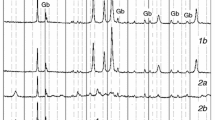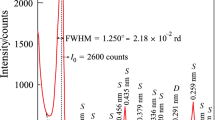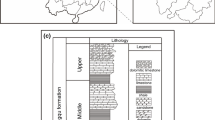Abstract
In this work, we have reinvestigated the thermal degradation kinetics of synthetic gypsum (CaSO4·2H2O) using a novel approach based on peak deconvolution followed by the application of Model-Free isoconversional method. Gypsum was prepared using wet chemical route and characterized by conventional X-ray diffraction, in situ high-temperature X-ray diffraction (HT-XRD), infrared spectroscopy (IRTF-ATR), simultaneous thermal gravimetry, and differential thermal technique (TG/DTA). The physicochemical analysis showed that gypsum thermally degrades into calcium sulfate anhydrite (γ-CaSO4; anhydrite III) via an intermediate phase formed by calcium hemihydrate (CaSO4·0.5H2O; bassanite). HT-XRD analyses revealed the difference between the bassanite and anhydrite III phases, although they have a similar structure. The thermal kinetics of gypsum indicated a complex behavior of overall process mechanism consisting of overlapping contributions, which were separated into two individual ones using a mathematical deconvolution of Fraser Suzuki function. The separate thermal processes were analyzed using Model-Free isoconversional and Malek’s methodology. The kinetic results showed that both processes may be represented by Johnson–Mehl–Avrami [JMA(n)] equation which corresponds to nucleation and growth mechanisms, with n > 1. The first process corresponding to the partial dehydration of gypsum into bassanite was carried out by a two-dimensional JMA mechanism, while the second process, attributed to the complete dehydration of gypsum, was performed according to a three-dimensional JMA. Calculations of thermodynamic parameters have shown that the dehydration process of gypsum is accompanied by endothermic effects and requires heat, in agreement with the thermal analysis data.










Similar content being viewed by others
References
Scheinherrová L, Doleželová M, Havlín J, Trník A. Thermal analysis of ternary gypsum-based binders stored in different environments. J Therm Anal Calorim. 2018;133:177–88.
Wang J, Yang P. Potential flue gas desulfurization gypsum utilization in agriculture: a comprehensive review. Renew Sustain Energy Rev. 2018;82:1969–78.
Yildizel SA. Mechanical performance of glass fiber reinforced composites made with gypsum, expanded perlite, and silica sand. Roman J Mater. 2018;48:229–35.
Zhang Q, Ma P, Yang Y, Pan X, Zhang J, Xiang L. Reinforcement of recycled paint slag hybrid-filled lightweight calcium sulphate whisker/PVC foam composites. J Environ Chem Eng. 2018;6:520–6.
Gorbovskiy KG, Ryashko AI, Kazakov AI, Norov AM, Mikhaylichenko AI. The influence of water-soluble impurities on thermal dehydration kinetics of phosphogypsum in self-generated atmosphere. J Therm Anal Calorim. 2018;133:1549–62.
Comodi P, Kurnosov A, Nazzareni S, Dubrovinsky L. The dehydration process of gypsum under high pressure. Phys Chem Miner. 2012;39:65–71.
McAdie HG. The effect of water vapor upon the dehydration of CaSO4·2H2O. Can J Chem. 1964;42:792–801.
Badens E, Llewellyn P, Fulconis JM, Jourdan C, Veesler S, Boistelle R, Rouquerol F. Study of gypsum dehydration by controlled transformation rate thermal analysis (CRTA). J Solid State Chem. 1998;139:37–44.
Carbone M, Ballirano P, Caminiti R. Kinetics of gypsum dehydration at reduced pressure: an energy dispersive X-ray diffraction study. Eur J Mineral. 2008;20:621–7.
Kontogeorgos DA, Founti MA. Gypsum board dehydration kinetics at autogenous water vapour partial pressure. Thermochim Acta. 2012;545:141–7.
Lou W, Guan B, Wu Z. Dehydration behavior of FGD gypsum by simultaneous TG and DSC analysis. J Therm Anal Calorim. 2011;104:661–9.
Arii T, Fujii N. Controlled-rate thermal analysis kinetic study in thermal dehydration of calcium sulfate dihydrate. J Anal Appl Pyrolysis. 1997;39:129–43.
Ball MC, Norwood LS. Studies in the system calcium sulphate–water. Part I. Kinetics of dehydration of calcium sulphate dihydrate. J Chem Soc A. 1969;1:1633–7.
Ballirano P, Melis E. Thermal behaviour and kinetics of dehydration of gypsum in air from in situ real-time laboratory parallel-beam X-ray powder diffraction. Phys Chem Miner. 2009;36:391–402.
Strydom CA, Potgieter JH. Dehydration behaviour of a natural gypsum and a phosphogypsum during milling. Thermochim Acta. 1999;332:89–96.
Strydom CA, Hudson-Lamb DL, Potgieter JH, Dagg E. The thermal dehydration of synthetic gypsum. Thermochim Acta. 1995;269–270:631–8.
Hudson-Lamb DL, Strydom CA, Potgieter JH. The thermal dehydration of natural gypsum and pure calcium sulphate dihydrate (gypsum). Thermochim Acta. 1996;282–283:483–92.
Putnis A, Winkler B, Fernandez-Diaz L. In situ IR spectroscopic and thermogravimetric study of the dehydration of gypsum. Mineral Mag. 1990;54:123–8.
Vyazovkin S, Burnham AK, Criado JM, Pérez-Maqueda LA, Popescu C, Sbirrazzuoli N. ICTAC kinetics committee recommendations for performing kinetic computations on thermal analysis data. Thermochim Acta. 2011;520:1–19.
Vyazovkin S, Chrissafis K, Di Lorenzo ML, Koga N, Pijolat M, Roduit B, Sbirrazzuoli N, Suñol JJ. ICTAC Kinetics committee recommendations for collecting experimental thermal analysis data for kinetic computations. Thermochim Acta. 2014;590:1–23.
Moine EC, Tangarfa M, Khachani M, El Hamidi A, Halim M, Arsalane S. Thermal oxidation study of Moroccan oil shale: a new approach to non-isothermal kinetics based on deconvolution procedure. Fuel. 2016;180:529–37.
Khachani M, El Hamidi A, Kacimi M, Halim M, Arsalane S. Kinetic approach of multi-step thermal decomposition processes of iron(III) phosphate dihydrate FePO4·2H2O. Thermochim Acta. 2015;610:29–36.
Song X, Zhang L, Zhao J, Xu Y, Sun Z, Li P, Yu J. Preparation of calcium sulfate whiskers using waste calcium chloride by reactive crystallization. Cryst Res Technol. 2011;46:166–72.
Koga N. A review of the mutual dependence of Arrhenius parameters evaluated by the thermoanalytical study of solid-state reactions: the kinetic compensation effect. Thermochim Acta. 1994;244:1–20.
Khawam A, Flanagan DR. Solid-state kinetic models: basics and mathematical fundamentals. J Phys Chem B. 2006;110:17315–28.
Vyazovkin S. Kinetic concepts of thermally stimulated reactions in solids: a view from a historical perspective. Int Rev Phys Chem. 2000;19:45–60.
Koga N, Šesták J, Šimon P. Some fundamental and historical aspects of phenomenological kinetics in the solid state studied by thermal analysis. Therm Anal Micro, Nano-Non-Cryst Mater Hot Top Therm Anal Calorim. 2012;9:1–28.
Malek J. The kinetic analysis of non-isothermal data. Thermochim Acta. 1992;200:257–69.
Deng C, Cai J, Liu R. Kinetic analysis of solid-state reactions: evaluation of approximations to temperature integral and their applications. Solid State Sci. 2009;11:1375–9.
Tang W, Liu Y, Zhang H, Wang C. New approximate formula for Arrhenius temperature integral. Thermochim Acta. 2003;408:39–43.
Perejón A, Sánchez-Jiménez PE, Criado JM, Pérez-Maqueda LA. Kinetic analysis of complex solid-state reactions. J Phys Chem B. 2011;115:1780–91.
Perejón A, Sánchez-Jiménez PE, Criado JM, Pérez-Maqueda LA. Thermal stability of multiferroic BiFeO3: kinetic nature of the β–γ transition and peritectic decomposition. J Phys Chem C. 2014;118:26387–95.
Bernard S, Fiaty K, Cornu D, Miele P, Laurent P. Kinetic modeling of the polymer-derived ceramics route: investigation of the thermal decomposition kinetics of poly[B-(methylamino)borazine] precursors into boron nitride. J Phys Chem B. 2006;110:9048–60.
Janković B, Manić N, Stojiljković D, Jovanović V. TSA-MS characterization and kinetic study of the pyrolysis process of various types of biomass based on the Gaussian multi-peak fitting and peak-to-peak approaches. Fuel. 2018;234:447–63.
Friedman HL. Kinetics of thermal degradation of char-forming plastics from thermogravimetry. Application to a phenolic plastic. J Polym Sci C. 1964;6:183–95.
Akahira T, Sunose T. Method of determining activation deterioration constant of electrical insulating materials. Res Rep Chiba Inst Technol. 1971;16:22–31.
Doyle CD. Estimating isothermal life from thermogravimetric data. J Appl Polym Sci. 1962;6:639–42.
Vyazovkin S. Evaluation of activation energy of thermally stimulated solid-state reactions under arbitrary variation of temperature. J Comput Chem. 1997;18:393–402.
Eyring H. The activated complex in chemical reactions. J Chem Phys. 1935;3:107–15.
Kolaitis DI, Founti MA. Development of a solid reaction kinetics gypsum dehydration model appropriate for CFD simulation of gypsum plasterboard wall assemblies exposed to fire. Fire Saf J. 2013;58:151–9.
Engbrecht DC, Hirschfeld DA. Thermal analysis of calcium sulfate dihydrate sources used to manufacture gypsum wallboard. Thermochim Acta. 2016;639:173–85.
Bezou C, Nonat A, Mutin JC, Christensen AN, Lehmann MS. Investigation of the crystal structure of γ-CaSO4, CaSO4·0.5H2O, and CaSO4·0.6H2O by powder diffraction methods. J Solid State Chem. 1995;117:165–76.
Christensen AN, Olesen M, Cerenius Y, Jensen TR. Formation and transformation of five different phases in the CaSO4 − H2O system: crystal structure of the subhydrate β-CaSO4·0.5H2O and soluble anhydrite CaSO4. Chem Mater. 2008;20:2124–32.
Tang Y, Gao J, Liu C, Chen X, Zhao Y. Dehydration pathways of gypsum and the rehydration mechanism of soluble anhydrite γ-CaSO4. J Am Chem Soc. 2019;4:7636–42.
Morris RJ. Infrared spectrophotometric analysis of calcium sulfate hydrates using internally standardized mineral oil mulls. Anal Chem. 1963;35:1489–92.
Mandal PK, Mandal TK. Anion water in gypsum (CaSO4·2H2O) and hemihydrate (CaSO4·1/2H2O). Cem Concr Res. 2002;32:313–6.
Saito T. Some observations on the process of dehydration and rehydration of gypsum by means of proton magnetic resonance. Bull Chem Soc Jpn. 1961;34:1454–7.
Prasad PSR, Chaitanya VK, Prasad KS, Rao DN. Direct formation of the γ-CaSO4 phase in dehydration process of gypsum: in situ FTIR study. Am Mineral. 2005;90:672–8.
Robertson K, Bish D. Constraints on the distribution of CaSO4·nH2O phases on Mars and implications for their contribution to the hydrological cycle. Icarus. 2013;223:407–17.
Ballirano P, Melis E. Thermal behaviour and kinetics of dehydration in air of bassanite, calcium sulphate hemihydrate (CaSO4·0.5H2O), from X-ray powder diffraction. Eur J Mineral. 2009;21:985–93.
Hu M, Chen Z, Wang S, Guo D, Ma C, Zhou Y, Chen J, Laghari M, Fazal S, Xiao B, Zhang B, Ma S. Thermogravimetric kinetics of lignocellulosic biomass slow pyrolysis using distributed activation energy model, Fraser-Suzuki deconvolution, and iso-conversional method. Energy Convers Manag. 2016;118:1–11.
Moine EC, Groune K, El Hamidi A, Khachani M, Halim M, Arsalane S. Multistep process kinetics of the non-isothermal pyrolysis of Moroccan Rif oil shale. Energy. 2016;115:931–41.
Borrachero M, Payá J, Bonilla M, Monzó J. The use of thermogravimetric analysis technique for the characterization of construction materials. J Therm Anal Calorim. 2008;91:503–9.
Starink MJ. The determination of activation energy from linear heating rate experiments: a comparison of the accuracy of isoconversion methods. Thermochim Acta. 2003;404:163–76.
Sbirrazzuoli N. Is the Friedman method applicable to transformations with temperature dependent reaction heat? Macromol Chem Phys. 2007;208:1592–7.
Fukami T, Tahara S, Nakasone K, Yasuda C. Synthesis, crystal structure, and thermal properties of CaSO4·2H2O single crystals. Int J Chem. 2015;15:12–20.
López-Beceiro J, Gracia-Fernández C, Tarrío-Saavedra J, Gómez-Barreiro S, Artiaga R. Study of gypsum by PDSC. J Therm Anal Calorim. 2012;109:1177–83.
Sarma LP, Prasad PSR, Ravikumar N. Raman spectroscopic study of phase transitions in natural gypsum. J Raman Spectrosc. 1998;29:851–6.
Kontogeorgos DA, Founti MA. Gypsum board reaction kinetics at elevated temperatures. Thermochim Acta. 2012;529:6–13.
Shannon RD. Activated complex theory applied to the thermal decomposition of solids. Trans Faraday Soc. 1964;60:1902–13.
Cordes HF. Preexponential factors for solid-state thermal decomposition. J Phys Chem. 1968;72:2185–9.
Chen Z, Chai Q, Liao S, Chen X, He Y, Li Y, Wu W, Li B. Nonisothermal kinetic study: IV. Comparative methods to evaluate Ea for thermal decomposition of KZn2(PO4)(HPO4) synthesized by a simple route. Ind Eng Chem Res. 2012;51:8985–91.
Vakhlu V, Bassi PS, Mehta SK. Thermoanalytical studies on gypsum dehydration. T Indian Ceram Soc. 1985;44:29–32.
Koga N, Tanaka H. A physico-geometric approach to the kinetics of solid-state reactions as exemplified by the thermal dehydration and decomposition of inorganic solids. Thermochim Acta. 2002;388:41–61.
Wada T, Nakano M, Koga N. Multistep kinetic behavior of the thermal decomposition of granular sodium percarbonate: hindrance effect of the outer surface layer. J Phys Chem A. 2015;119:9749–60.
Boonchom B. Kinetics and thermodynamic properties of the thermal decomposition of manganese dihydrogenphosphate dihydrate. J Chem Eng Data. 2008;53:1533–8.
Acknowledgements
The authors gratefully acknowledge the staff of the physicochemical analysis platform of the Faculty of Sciences (University Mohammed V-Rabat) for their close collaboration and discussions.
Author information
Authors and Affiliations
Corresponding author
Additional information
Publisher's Note
Springer Nature remains neutral with regard to jurisdictional claims in published maps and institutional affiliations.
Rights and permissions
About this article
Cite this article
El Hazzat, M., Sifou, A., Arsalane, S. et al. Novel approach to thermal degradation kinetics of gypsum: application of peak deconvolution and Model-Free isoconversional method. J Therm Anal Calorim 140, 657–671 (2020). https://doi.org/10.1007/s10973-019-08885-3
Received:
Accepted:
Published:
Issue Date:
DOI: https://doi.org/10.1007/s10973-019-08885-3




